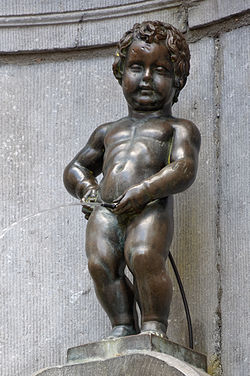Our website is made possible by displaying online advertisements to our visitors.
Please consider supporting us by disabling your ad blocker.
Manneken Pis
| Manneken Pis | |
|---|---|
 | |
 Location within Brussels | |
| Artist | Jérôme Duquesnoy the Elder |
| Year |
|
| Type | Bronze |
| Subject | Puer mingens |
| Dimensions | 55.5 cm (21.9 in) |
| Location | City of Brussels, Brussels-Capital Region, Belgium |
| 50°50′42″N 4°21′00″E / 50.8449861°N 4.3499932°E | |
| Website | Official website |
Manneken Pis (pronounced [ˌmɑnəkə(m) ˈpɪs] ⓘ; Dutch for 'Little Pissing Man') is a landmark[1] 55.5 cm (21.9 in)[a] bronze fountain sculpture in central Brussels, Belgium, depicting a puer mingens; a naked little boy urinating into the fountain's basin. Though its existence is attested as early as the mid-15th century,[2] Manneken Pis was redesigned by the Brabantine sculptor Jérôme Duquesnoy the Elder and put in place in 1619.[3][4][5] Its stone niche in rocaille style dates from 1770.[6][4] The statue has been repeatedly stolen or damaged throughout its history. Since 1965, a replica has been displayed,[7] with the original stored in the Brussels City Museum.[4][8]
Manneken Pis is one of the best-known symbols of Brussels and Belgium, inspiring several legends, as well as numerous imitations and similar statues both nationally and abroad.[9][10] The figure is regularly dressed up and its wardrobe consists of around one thousand different costumes. Since 2017, they have been exhibited in a dedicated museum called GardeRobe MannekenPis.[11][12] Owing to its self-derisive nature, Manneken Pis is also an example of belgitude (French; lit. 'Belgianness'),[13] as well as of folk humour (zwanze) popular in Brussels.[14][15]
Manneken Pis is approximately five minutes' walk from the Grand-Place/Grote Markt (Brussels' main square), at the junction of the Rue du Chêne/Eikstraat and the pedestrian Rue de l'Étuve/Stoofstraat.[5] This site is served by the premetro (underground tram) station Bourse/Beurs (on lines 4 and 10), as well as the bus stop Grand-Place/Grote Markt (on lines 33, 48 and 95).[16][17][18]
- ^ "Brussels Landmarks and Monuments: Brussels-Capital Region, Belgium". www.world-guides.com. Retrieved 2 February 2018.
- ^ Deligne 2008.
- ^ Miller 1998.
- ^ a b c De Roose 1999, p. 20–23.
- ^ a b De Vries 2003, p. 51–54.
- ^ Des Marez 1918, p. 144.
- ^ Willsher, Kim (6 August 2015). "Fake pisstake? Scientists re-examine Belgium's celebrated Manneken Pis". The Guardian. Retrieved 7 June 2017.
- ^ Couvreur, Deknop & Symons 2005, p. 26.
- ^ Couvreur, Deknop & Symons 2005.
- ^ Emerson 2015.
- ^ Cite error: The named reference
:0was invoked but never defined (see the help page). - ^ Cite error: The named reference
:2was invoked but never defined (see the help page). - ^ Bainbrigge, Susan (2009). Culture and identity in Belgian francophone writing: dialogue, diversity and displacement. Peter Lang. ISBN 978-3-03-911382-8.
- ^ State 2004, p. 356.
- ^ "ZWANZE: Définition de ZWANZE". www.cnrtl.fr (in French). Retrieved 2 February 2018.
- ^ "Ligne 33 vers DANSAERT - stib.be". www.stib-mivb.be. Retrieved 23 July 2023.
- ^ "Ligne 48 vers ANNEESSENS - stib.be". www.stib-mivb.be. Retrieved 23 July 2023.
- ^ "Ligne 95 vers GRAND-PLACE - stib.be". www.stib-mivb.be. Retrieved 23 July 2023.
Cite error: There are <ref group=lower-alpha> tags or {{efn}} templates on this page, but the references will not show without a {{reflist|group=lower-alpha}} template or {{notelist}} template (see the help page).
Previous Page Next Page


